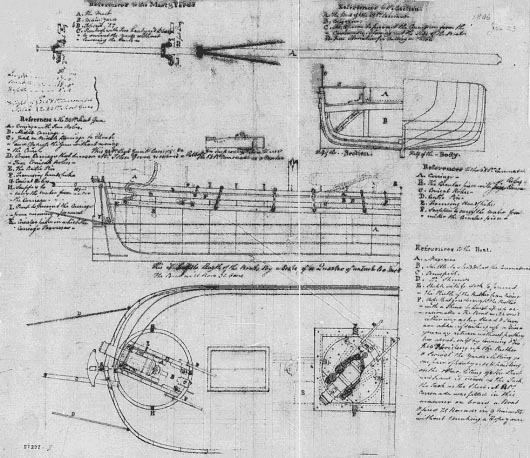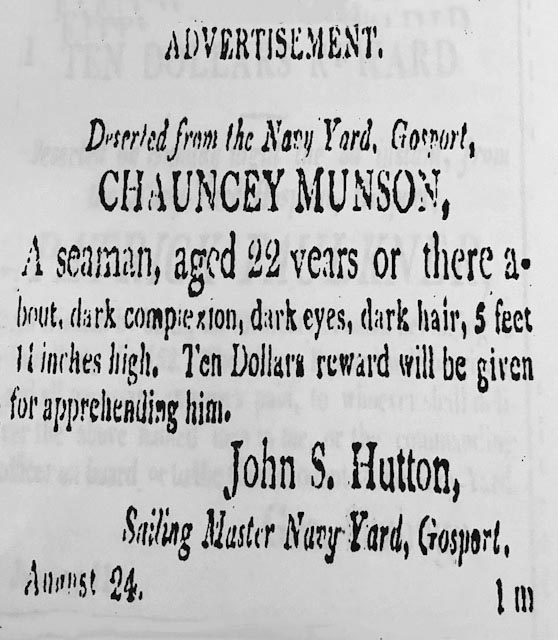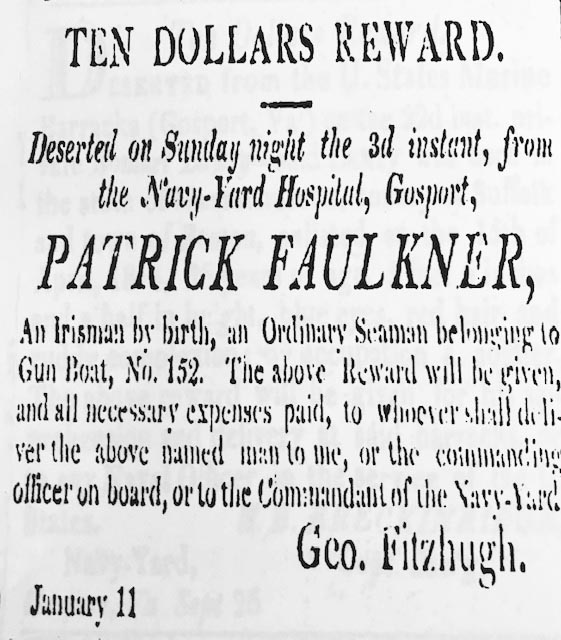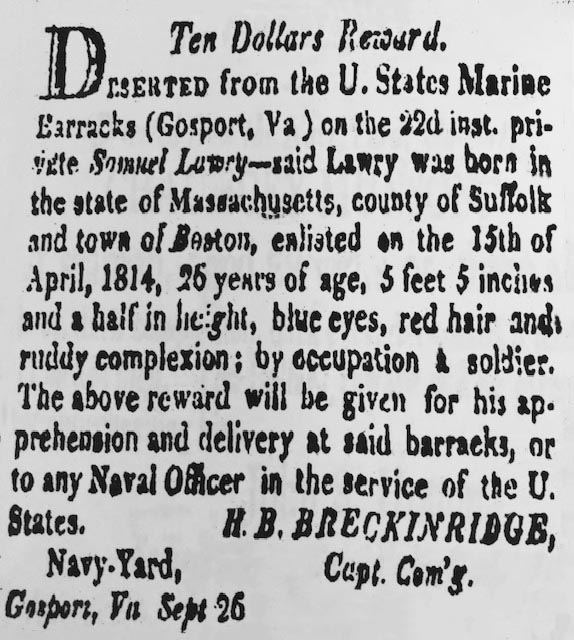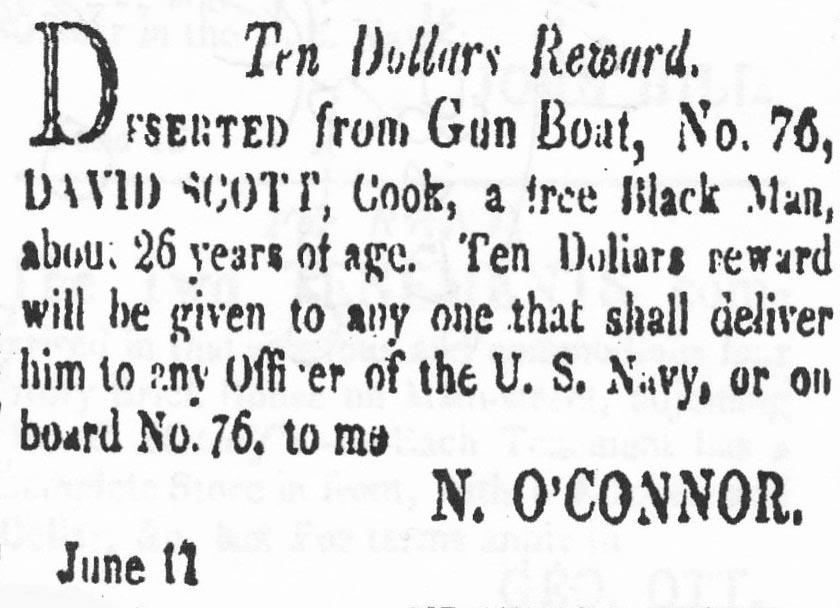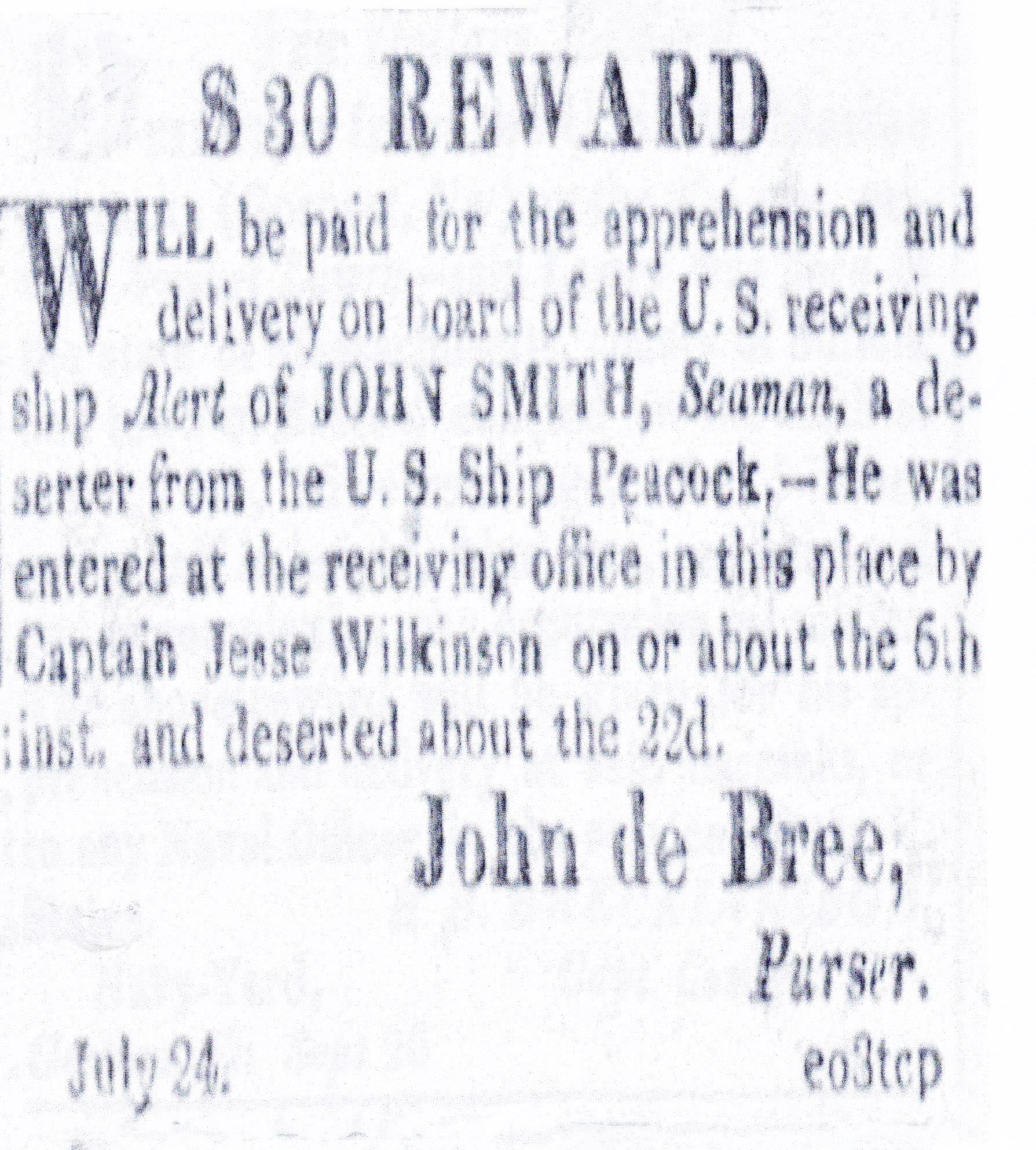In the pre-1815 Navy desertion was a serious problem. The most common of offences tried by Court Marshall for enlisted personnel was desertion.1 In the early United States military, desertion was high by modern standards and by far a vexing loss. While exact statistics were not recorded during the summer months of 1813, the USS Constitution “seems to hemorrhage men, with 46 sailors stealing away to freedom.”2 In contrast to Britain, in the United States Navy all seamen were volunteers. The only seamen who were forcibly recruited or impressed against their wills were officer’s “servants” enslaved seaman) who were often brought aboard by slaveholding officers.
1 McKee, Christopher, A Gentlemanly and Honorable Profession: The Creation of the U.S. Officer Corps, 1794- 1815 (United States Naval Institute, Annapolis, 1991) p. 248.
2 Charles E. Brodine Jr., Michael J. Crawford and Christine F. Hughes Ironsides! The Ship, the Men and the Wars of the USS Constitution Fireship Press, p.51
Why did men desert? The reasons were many, but at a basic level many disliked being a sailor and wanted a better life ashore. The pay was low at $12 per month for an Able Seaman, $10 per month for an Ordinary Seaman and $6-10 per month for Boys.3 Another factor was most of the deserters were never caught, and, of the 39 deserters from the USS Constitution, 33 were not apprehended or tried. If caught the punishment could be severe, with flogging being the most common, the median number of lashes being 72! Money was the big factor in why men deserted. While exact figures are not available, the wage of an ordinary seaman in 1805 was $6-8 per month, and, so for those who needed more money and better conditions, most shipyards needed labor and even the most unskilled laborer could earn a dollar a day (see the WNY payroll for 1811).4
3 American State Papers, Naval Affairs, Volume 1, p. 251. “Estimate of Pay and Rations for Officers and Crew.”
4 Sharp, John G., Washington Navy Yard, payroll of mechanics and laborers for July 1811 http://genealogytrails.com/washdc/WNY/1811payroll.html accessed 28 April 2021
Following the war of 1812, the problem of desertion still loomed large at Gosport (Norfolk) Navy Yard. Commodore James Barron believed the problem was a lack of Marine sentries to prevent the new recruits from simply getting their first pay and deserting the station. He also stressed punishment had to include military court martials.
In his letter Barron attempted to explain that new recruits in 1828 were typically lodged either on the receiving ship USS Alert or in the Marine Barracks, with only minimal sentries to maintain a watch.. In all there were fourteen Marines aboard the USS Alert, barely enough to cover a three section watch. The Marine contingent consisted of twelve privates and two corporals, as enumerated for the April through June 1828 muster roll of the USS Alert. In the pre-1815 U.S. Navy desertion was a serious offence and accounted for nearly three quarters of all court martial convictions.5 Some ships had higher desertion rates: for example, Chauncey Munson and Patrick Faulkner both were part of the crew of Gun Boat 152. These small ships measured about 50 to 75 feet long and 15 to 20 feet in the beam, with a shallow draft for use in the shoal waters of America's harbors. They were variously rigged with oars and sails, and crewed by up to twenty men. On the plus side, if the wind failed or if they were engaged in close combat, they could be propelled by oars. Each gunboat carried two to three guns: 18-24-pound swivel-mounted guns or 32-pounders on traversing carriages. They were copper-bottomed and rigged with one or two masts and manned by a crew of twenty to thirty men. Munson deserted briefly in 1812; however, naval records reflect he continued to serve on various vessels such as the USS Erie and USS Saranac after the war, whereas Patrick Faulkner apparently made good his escape. Likewise Private Samuel Lawrey, USMC, made good his escape from the corps after entering the Naval Hospital at Gosport, Virginia, in July 1815
5 McKee, p. 495.
The small congressional naval appropriations for 1827 and the following years hindered Commodore James Barron’s call to Secretary of the Navy, Samuel L.Southard, for more funds and additional Marines at Gosport Navy Yard to maintain security and check desertions.6 Alas, nothing came of his request and on 6 October 1829 Commodore Barron yet again wrote a similar plea to the new Secretary John Branch and requested more sentries and severer punishments.7
6 Barron to Samuel L Southard, 19 April 1827 “Captains letters” NARA M125 RG 260, 19 Mar 1827 to 14 May 1827, Volume 111, Letter 39
7 Barron to Samuel L. Southard, 14 May 1829 “Captains letters” NARA M125 RG 260, 1 May to 30 May1829, Volume 137, Letter 20
John G.M. Sharp
April 28, 2021
**********
Miscellaneous Records of the Navy Department, 1811-1814, Muster Rolls, Gun Boat 152, RG 45
National Archives and Records Administration, Washington, DC.
Enlarge in Browser
**********
Commandants Office
United States Navy Yard
Gosport April 19th 1827Sir,
I have the honor to acknowledge receipt of your letter of the 13th instant and should not have importuned you again on this subject, if I did not feel myself constrained by candor to acknowledge that the desertion that took place from the crew of the Alert occurred in this Yard, and not from that Ship. This arises from the present condition of our enclosure, and the feeble state of the Marine guard attached to this Yard, and not withstanding all our vigilance still appears to require particular attention to some efficient remedy. I have therefore most respectfully to suggest that no punishment which we are authorized to inflict has or will put an end to this injurious practice, but I believe that a more formal and of course more severe chastisement would effectively check this disposition in the men to change their situations and it is this alone by which they are actuated, for it is next to an impossibility for the crew of any ship to be better treated than the Alerts are, and have been since Lieutenant Farragut joined her. We have generally a sufficient number of officers near at hand to form a Court, and a few examples accompanied by judicious course of admonishment would I think have a beneficial effect, if not entirely remove the will.
I have the honor to be
Sir Most Respectfully
Your Obedient Servant
James Barron**********
John "Jack" G. M. Sharp resides in Concord, California. He worked for the United States Navy for thirty years as a civilian personnel officer. Among his many assignments were positions in Berlin, Germany, where in 1989 he was in East Berlin the day the infamous wall was opened. He later served as Human Resources Officer, South West Asia (Bahrain). He returned to the United States in 2001 and was on duty at the Naval District of Washington on 9/11. He has a lifelong interest in history and has written extensively on the Washington, Norfolk, and Pensacola Navy Yards, labor history and the history of African Americans. His previous books include African Americans in Slavery and Freedom on the Washington Navy Yard 1799-1865, Morgan Hannah Press 2011. History of the Washington Navy Yard Civilian Workforce 1799-1962, 2004.
https://www.history.navy.mil/content/dam/nhhc/browse-by-topic/heritage/washington-navy-yard/pdfs/WNY_History.pdf
and the first complete transcription of the Diary of Michael Shiner Relating to the History of the Washington Navy Yard 1813-1869, 2007/2015 online:
https://www.history.navy.mil/research/library/online-reading-room/title-list-alphabetically/d/diary-of-michael-shiner.html
His most recent work includes Register of Patients at Naval Hospital Washington DC 1814 With The Names of American Wounded From The Battle of Bladensburg 2018,
https://www.history.navy.mil/research/library/online-reading-room/title-list-alphabetically/r/register-patients-naval-hospital-washington-dc-1814.html
The last three works were all published by the Naval History and Heritage Command. John served on active duty in the United States Navy, including Vietnam service. He received his BA and MA in History from San Francisco State University. He can be reached at sharpjg@yahoo.com
* * * * * * * * * *
Norfolk Navy Yard Table of Contents
